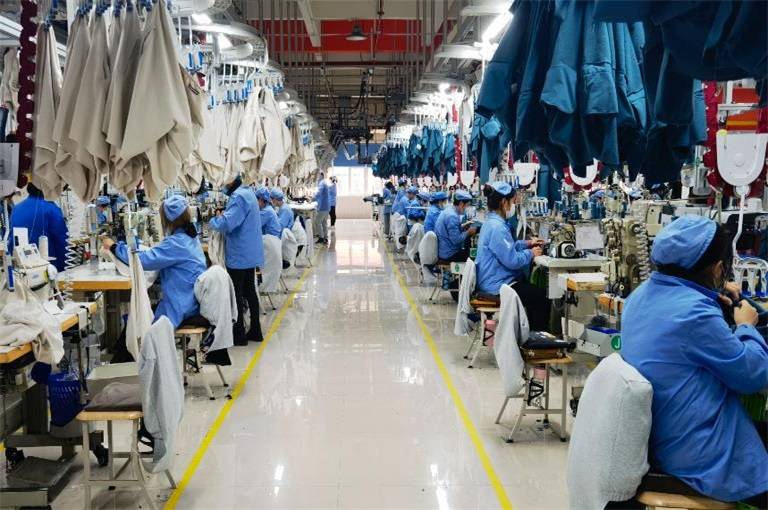Detailed introduction to ERP production management in clothing factories [functions, precautions, prices, etc.]
The ERP production management module of a clothing factory is a software system used to help manage and monitor the clothing production process. 1、 Clothing factory ERP production management function 1. Order management: Track and manage all clothing orders, including order receipt, order status, delivery date, and other information. It can generate order reports and statistical data to assist management personnel in making decisions and planning. 2. Production plan: Develop a production plan based on order requirements and production capacity. By considering factors such as materials, equipment, and human resources, production tasks are arranged reasonably to ensure timely delivery. 3. Material management: Manage the raw materials and accessories required for clothing production. Track material inventory, automatically generate material purchase orders, and ensure timely and accurate material supply.

4. Production progress tracking: Monitor the progress of each link in the production process. Real time update of production progress, identification and resolution of potential production issues, timely adjustment of plans to maintain high production efficiency. 5. Quality control: Establish quality standards and processes to monitor product quality. Record and track product quality issues, implement corrective measures to ensure that products meet quality requirements. 6. Process management: Manage the process flow and manufacturing methods of clothing production. This includes developing process procedures, training operators, monitoring process parameters, etc., to improve production efficiency and product quality. 7. Equipment maintenance: Track and manage the maintenance and upkeep of production equipment. Regularly check the status of the equipment, perform maintenance and upkeep to ensure its normal operation, reduce malfunctions and downtime. 8. Production reports and analysis: Generate various production reports and analysis data, including production volume, production efficiency, production costs, etc. By analyzing data, understanding the production situation, identifying problems and improvement opportunities. 2、 Notes on using ERP production management in clothing factories: 1. Detailed understanding of business requirements: Before implementing the ERP system, ensure comprehensive research and analysis of the production management needs of the clothing factory. Understand the specific requirements of production process, order management, material requirements, etc., in order to correctly configure and customize the system. 2. Find a suitable ERP system: There are various ERP systems available in the market to choose from, ensuring the selection of a system that is suitable for the production management needs of clothing factories. Consider factors such as system functionality, usability, flexibility, and scalability, as well as the reputation and support services of the supplier. 3. Training and technical support: Ensure that relevant employees receive system training and understand how to use the ERP production management module correctly. Training can help employees become familiar with the system interface, functions, and workflow, and improve their operational efficiency. At the same time, ensure to receive technical support from suppliers and promptly solve any problems and difficulties encountered. Intelligent management of ERP production in clothing factories 4. Data management and backup: Establish a reasonable data management strategy, including data backup and recovery plans. Regularly backup data to ensure its security and integrity. In addition, establish data access permissions and security control policies to ensure that only authorized personnel can access and modify data. 5. Staged implementation: For large ERP systems, a phased implementation approach can be considered. Divide the system functional modules into different stages for implementation, gradually going live and running. This can reduce implementation risks and make it easier for employees to adapt to changes in the system. 6. Continuous improvement and optimization: The implementation of an ERP system is not a one-time task, but a process of continuous improvement and optimization. Regularly evaluate the effectiveness of the system, collect user feedback, and make adjustments and optimizations for issues and improvement opportunities to enhance the value and adaptability of the system. 3、 The price of ERP production management system in clothing factories varies depending on the supplier, functionality, and customization requirements. The following are some main factors that affect prices: 1. Suppliers: Different ERP suppliers may have differences in pricing. Renowned ERP suppliers typically provide fully functional, stable, and reliable systems

3. User licenses: The price of ERP systems is usually related to the number of user licenses. The increase in the number of licenses will result in higher fees. 4. Deployment method: ERP systems can be deployed based on cloud computing or locally. The cloud computing model is usually provided through subscription, with billing based on the number of users, storage space, or usage duration. Local deployment may require additional hardware and software costs, as well as related maintenance and support costs. 5. Implementation and training: The implementation and training of an ERP system is an additional cost. Implementation costs typically include system configuration, data migration, and integration. The training costs involve user training, support, and maintenance. 6. Maintenance and support: The maintenance and support of an ERP system is a continuous expense. Typically, suppliers provide maintenance and technical support plans, and their costs may be based on factors such as contract terms and service level agreements. Due to the complexity and variability of these factors, specific price ranges cannot be provided. If you are interested in a specific clothing factory's ERP production management system, it is recommended to directly contact the supplier for detailed pricing consultation in order to obtain accurate quotations based on your needs.





